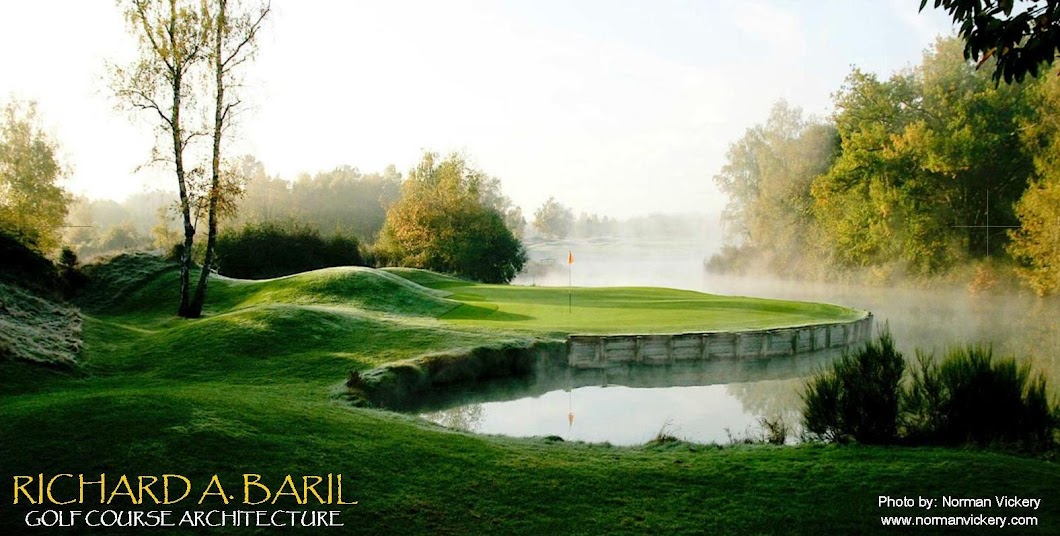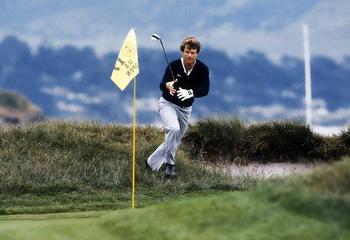This was originally written in 2010. But, I never got around to posting it. Anfi Tauro golf course is the longest golf construction project I've been involved with; spanning 10 years.
In many ways, it was an extremely complicated and difficult design project, given the site constraints and the ever changing construction process. Not to mention the space restrictions, topography and ROCK.
Mr. von Hagge traveled to Gran Canaria to meet with Sr. Lyng and interview for the design commission. Unfortunately, it was the only time he visited Gran Canaria. I would have particularly enjoyed sharing this design experience with him. Sadly, Mr. von Hagge never returned to Gran Canaria.
Also, sadly, Sr. Lyng did not live to see the completion of Anfi Tauro golf course.
Sr. Lyng (left), Jan Syltern and Robert von Hagge
Hole #6 (shown below) now occupies the ridge that is shown right behind these gentlemen.
The peak which remains today, behind #6 green, is right above Sr. Lyng.
The peak which remains today, behind #6 green, is right above Sr. Lyng.
circa 2000
 |
| Anfi Tauro #6 circa 2006 |
 |
| Javier Suarez (left) with Sr. Lyng - May 2006. This was the last time I saw Sr. Lyng. Javier Suarez was instrumental in finally getting the golf course constructed. |
The most unique aspect of this project for me was dealing with my evolving design philosophy over the 10 years it took to realize this project. Of course, it was incumbent on me to deliver a "von Hagge" design, which has been my role for all our European designs. But, this project was different. At Anfi Tauro, over the 10 years we dealt with various construction entities, changing managers, changing site constraints and a change in ownership late in the project. And, my design philosophy continued to evolve during this time. I struggled to maintain consistency in the golf course. I fought the desire to modify completed holes, and make sure ongoing work was not a significant departure from the initial work. Each new regime brought changes to the plans. These had to be addressed and incorporated into the golf course. As an example, hole #1 was built and grassed three separate times over the years! It was truly a unique project.
ANFI TAURO
Bjorn Lyng was diagnosed with heart problems. (At one point, by coincidence, he was referred to the Medical Center in Houston, Texas) His doctors prescribed, among other things, rest and retirement. So, Sr. Lyng "retired" to Gran Canaria, an island he discovered years earlier while sourcing water valves he needed to refurbish a paper mill in Norway.
For a short time, his days were spent fishing. But, ever the restless industrialist, he was interested in much bigger "fish". Growing restless, his mind began fishing for something bigger; something on which he could focus his massive intellect and boundless energy.
He told the following story about his discovery - "Fishing one day, I was admiring the rugged coastline, mesmerized by the mountains entering the ocean. Then, it occurred to me, the particular mountain ridge I was looking at could be cut in half to create a resort. The excavated part of the mountain could be used to create a marina."
Only an extraordinary intellect, dares to dream this big. Sr. Lyng purchased the land and the his fishing vision started to become a reality. And, Anfi del Mar was born; shown below in it's early stages of construction....
 |
| ANFI DEL MAR - GRAN CANARIA |
 |
| ANFI TAURO MASTERPLAN |
ANFI TAURO GOLF COURSE
The design for Anfi Tauro is inextricably linked to the unique landscape the golf course occupies. The Tauro valley is a dramatic, varied and expansive desert landscape, with a magnificent and rugged mountain structure. These attributes "set the stage" and frame the golf course. It was obvious that - even if we wanted to - it would be impossible to design a golf course that did not cooperate and respectfully merge into this majestic landscape. Our desire, from the beginning, was to create a golf course that would celebrate and highlight the energy of the landscape.  |
| Early sketch for hole #1 |
You will note that only the "play areas" of the golf course are grassed and irrigated. The purpose of this is twofold: 1. It reduces, to the logical minimum, the irrigated area. Of course, this is an important point in any golf project but it is critically important in Gran Canaria. 2. By confining the grass/irrigation only to the play areas, we created a very stark and dramatic color contrast (green) to the adjacent landscape. This creates a very dramatic visual effect, which we felt was important. It is a very clear and pure representation of the struggle between the manicured golf course and the formidable natural landscape – that we wanted to highlight.
 |
| Anfi Tauro #17, highlighting the scale of earthmoving required to build the course. |
Sr. Lyng asked us to create the best possible golf course possible within the Anfi landscape. It was a simple directive with many mitigating circumstances that spanned many years. Our intention, which is a constant objective, was to create the most memorable, entertaining and fun golf experience possible.
Since Anfi is a “resort” course, it means the golf course must be easily and immediately comprehensible. Since there will likely be many people that only play the course a few times, they must be able to understand the tactical requirements. At the same time, the course cannot be so rudimentary as to be uninspiring. Also important, Anfi is intended to provide a truly memorable visual experience. We want the players to leave with unchallenged, unparalleled memories of a unique and inspiring landscape. Finally, the golf course must engage and challenge the best players and entertain the beginning and average players.
What were the main difficulties and challenges during the execution of the project?
Now this is truly a difficult to question to answer in a brief way..... I only have time to provide a list which I could perhaps elaborate on in the future:
• The site – mostly rock, a limited amount of space, severe topography.
• The construction – limited experience of the construction company, logistical problems, projects delays leading to changes in workers and management and re-learning.
• Water
• Extended time – challenged the cohesiveness of the original design, design process and design philosophy.
• Permitting/authorities
 |
| Anfi Tauro #13 green, overlooking Tauro valley. |
Anfi Tauro is an ambitious dream of one man, that was shared with many and nurtured through many hardships to become a reality. I believe there has not been a more ambitious golf project built in Europe. The obstacles were simply too overwhelming to be overcome by a normal person. Of course, this is a compliment to the dedication and compelling power of Sr. Lyng, and his unwavering conviction to make dreams into reality.
Today, the path which was originally set by Sr. Lyng is now being followed and pursued by Santana-Cazorla. Under the tutelage of Javier Suarez, we believe the golf course will attain international recognition as a golfing destination.
Anfi Tauro golf course is unique in many ways. It is a golf course that resides in an extremely powerful and dramatic landscape. This provides a visual feast unparalleled anywhere. The design provides varied and complete challenges, intended to train and improve golfing skills - while entertaining golfers. The course is maintained at the highest level.
In the next years, as the final landscape touches are complete and the landscape mends and merges with the golf course, Anfi will mature into a truly striking and outstanding experience and hopefully become a recognized international golf venue.
INTERESTING FOLLOW-UP
I found this review (below) recently. Such kind words are rewarding to designers. This review is particularly rewarding for me. I spent nearly 30 years working with Mr. von Hagge and took great pride in my association with him. It was truly an honor for me. Robert was always concerned about projects like Anfi Tauro, that he didn't visit often. Eventually, his health prevented him from traveling to Europe and visiting our ongoing projects. He would be concerned these projects were not being developed to his standard. He would be happy to see a "von Hagge" admirer felt Anfi Tauro expresses is "maximum creativity". He would also be proud the golf course seems more impossible to play than it is. This was one of Robert's design tenets: to design a golf course that appears more difficult than it is... Robert was an artist and he would have loved the description: "Every hole looks like a painting, from nature and sometimes breathtaking."
"Arizona to Gran Canaria: spectacular"
Jan 6, 2012 A TripAdvisor Member
Von Hagge is the architect of my favorite golf courses. At Anfi Tauro Golf he has expressed his maximum creativity. At first glance, we are faced with a path that seems impossible, then, hole after hole, you become more familiar and fun is guaranteed. I, handicap 19, I've always used the drive without fear and the result was a score below 90 shots. Every hole looks like a painting from nature and sometimes breathtaking. The camp is held in an exemplary manner. Congratulations to the FIFe and especially Von Hagge.







